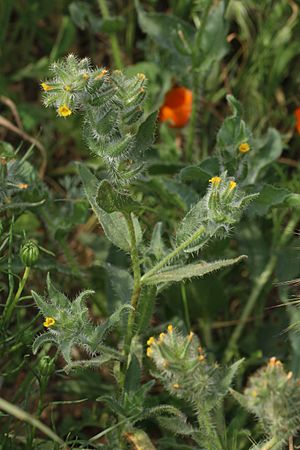Bristly fiddleneck facts for kids
Quick facts for kids Bristly fiddleneck |
|
|---|---|
 |
|
| Scientific classification | |
| Genus: |
Amsinckia
|
| Species: |
tessellata
|
Amsinckia tessellata is a type of plant often called a fiddleneck. It gets this name because its flowers grow in a coiled shape, like the head of a fiddle. People also know it by other names such as bristly fiddleneck, tessellate fiddleneck, checker fiddleneck, and even devil's lettuce.
This plant naturally grows in dry areas of western North America. You can find it in places like eastern Washington and Idaho, most of California, and a large area called the Great Basin. It also grows in southwest New Mexico in the U.S., and in northwest Sonora and Baja California in Mexico. It usually lives in areas below 6,000 feet (about 1,800 meters) in elevation.
Amsinckia tessellata is a common plant. It thrives in many different environments. These include chaparral (dry, bushy areas), oak forests, dry scrublands, and temperate valleys. It can also be found in areas that have been disturbed by humans. This plant grows well in deserts, including the Mojave Desert and the Sonoran Desert.
What Does It Look Like?
Amsinckia tessellata is an annual herb. This means it grows from a seed, flowers, produces new seeds, and then dies all within one year. It typically stands about 8 to 24 inches (20 to 60 centimeters) tall. The plant is quite bristly, meaning it has stiff, rough hairs all over it. It looks similar to other fiddleneck plants.
Its Flowers
The flowers of Amsinckia tessellata grow in a coiled cluster. This cluster is called an inflorescence. The flowers themselves are yellow to orange in color. They are shaped like tubes and can be up to about one centimeter wide at the opening. Each flower often has fewer than five petals, or "lobes." The green parts that protect the flower bud, called calyx lobes, are not all the same width. Sometimes, they are joined together below the middle. This plant usually blooms from March to June.

